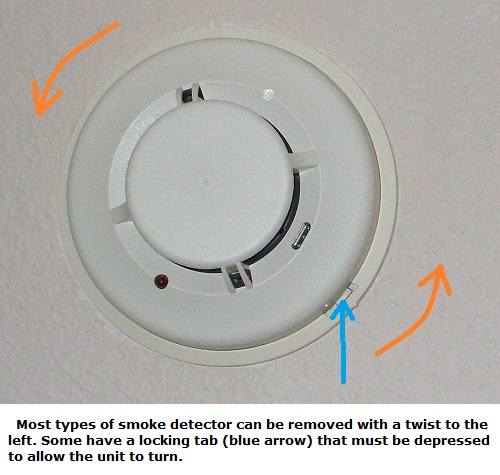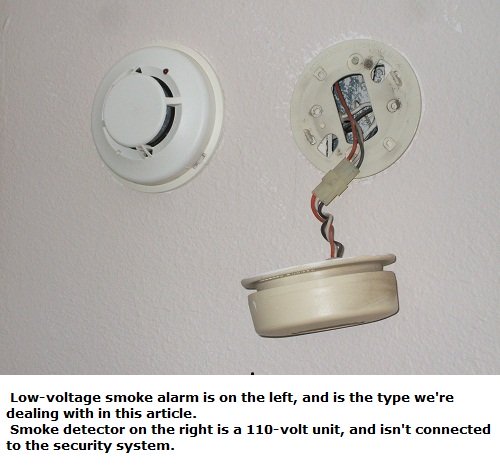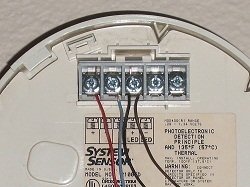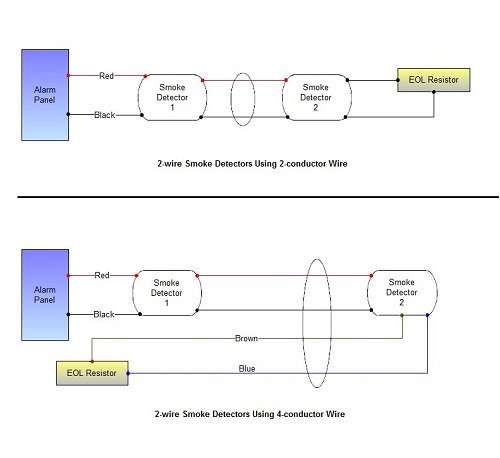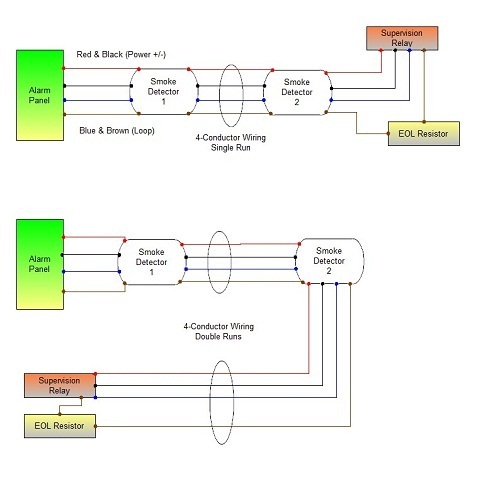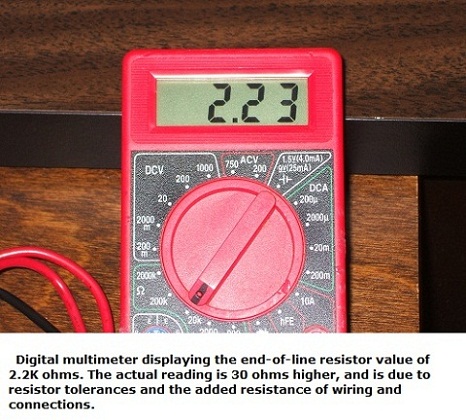- Home
- Compare Systems
- Cheap Systems
- Free Quotes
- DIY Systems
- Hardwired Systems
- Wireless Systems
- Smoke Detectors
- Medical Alarms
- Alarm Monitoring
- Cameras & Video
- Ademco
- ADT Security
- Brinks Security
- Broadview
- DSC Security
- FBI Alarms
- GE Security
- Honeywell
- Link Interactive
- Monitronics
- Moose
- Napco
- Protection 1
- Radionics
- Simplisafe
- Alarm Manuals
- Alarm System Parts
- Alarm Tools
- Troubleshooting
- FAQ
- Glossary
- Sitemap
- About Me
- Contact Me
Troubleshooting Smoke Alarm Wiring at the Detectors
If you’re checking smoke alarm wiring because of a fire alarm trouble condition, you’ll be looking in two areas: First, you’ll need to check connections at the fire alarm zone in the main panel. Next, test the wiring at each smoke detector in the house.
The first part of the process is explained in “Smoke Alarm Circuit Troubleshooting”.
The page you’re on now covers the second part of troubleshooting, checking the smoke alarm wiring at the smoke detectors.
You can do these steps in either order, depending on your situation. However, if you’re just starting the troubleshooting process, please read the information on smoke alarm circuits first. It will help you decide whether or not to even begin working on your own alarm system or not.
Whatever you decide to do, just be sure to keep track of what you find. Make notes of your results, both at the main panel and at each smoke detector location. This will prevent wasted time, and make figuring out the problem easier.
For more details on fire alarm wiring, check out Smoke Detector Circuit Basics and Smoke Detector Wiring - Connecting Multiple Runs.
Caution:
If your system is monitored, be sure to call the central station and put the alarm on “Test” before disconnecting any smoke alarm wiring!
Failure to do so could result in the fire department being dispatched to your house, and possible false alarm fees.
Checking Connections in the Field
Begin by removing each smoke detector along the affected wire run, visually checking for any loose or damaged wires. Smoke alarm wiring should be securely fastened to screw terminals, and any removable terminal strips should be firmly seated on the detector.
First, look for water stains, moisture, corroded terminals, or any other signs of water damage. Often, water from a roof leak will seep down onto the ceiling drywall. Once there, it will spread out until it finds an opening. Any devices attached to the ceiling may be affected, including hardwired smoke detectors.
Besides water damage, check for any signs of rodent chew. This isn’t uncommon, and it’s easy to spot. Look for sections of smoke alarm wiring with jacketing or insulation missing, along with rough, nibbled-on edges. These are sure signs of rodent activity. If this is the case, wiring can be repaired as needed; for a long-term solution, be sure to contact a pest control professional to trap the culprits. They can also help you with vermin-proofing your house against future invasions.
If you find anything wrong at a smoke detector, correct it if it’s easy to do so. For example, loose smoke alarm wiring can be reconnected to the proper screw terminal and tightened. Bare wires exposed by rodent chewing can be trimmed back to fresh wire, re-stripped, and re-connected.
If you find a smoke alarm damaged by water, it will have to be replaced. You can temporarily bypass it, in order to finish the troubleshooting process. First, remove all wiring from the smoke detector, and set it aside. You’ll want to refer to it to find a replacement unit. Next, splice the wires back together, color for color, to re-establish a continuous wire run. Continue testing the remaining detectors, to make sure there aren’t any other problems.
2 Wire Smoke Detectors
Two-wire home smoke detectors will be looped from the main alarm panel, out to each detector in the house. At the last smoke alarm in the run, look for the end-of-line resistor. It will usually be installed at the last smoke unit in the run, but it may be located back at the panel. Compare your wiring to the smoke detector wiring diagram for 2-wire smokes.
More information on 2 Wire Smoke Detectors.
4 Wire Smoke Detectors
2 wire connections are fairly simple to trace, but 4-wire smoke runs can add an extra twist. In addition to an end-of-line resistor, 4-wire installations may also use an end-of-line power supervision relay. If power is lost to the smoke detectors, the relay will drop out. This causes an open loop condition on the detector loop, alerting you that there is a problem.
If you have 4 wire smoke detectors, and also have an open loop problem, make sure the EOL relay is working properly.
First, locate the EOL relay; it will most likely be located at the smoke detector furthest from the alarm panel. Next, disconnect the loop wiring from the relay leads, and meter the leads for continuity. A good relay will show a short across these two leads, while a bad one will show an open circuit.
If it tests “good”, re-connect it to the smoke loop wires. If it fails the test, splice the loop wires together to bypass the relay, and continue troubleshooting.
Learn more information on 4 Wire Smoke Detectors.
Diagnosing the Problem
After any problems have been located and either repaired or bypassed, take your meter back to the main panel. Meter the smoke alarm circuit again, and you should see the value of the EOL resistor.
If you do, congratulations! You’ve successfully repaired your smoke alarm wiring, and you can rest assured of continued fire protection. Follow the steps under “Re-connecting Smoke Alarm Wiring” below.
If you don’t get a good reading, then wiring is damaged between the panel and the last detector on the run.
If you have attic or crawl space, and feel pretty adventurous, you can try to find the problem yourself. Use your notes to isolate where the smoke alarm wiring has an issue, and trace the bad spot down. This is “above and beyond” the abilities of many people. Even a do it yourself security system wouldn't usually involve this level of effort.
If you’re like most people, this is the point where you call in a professional alarm company. They will have the tools, skills, and experience to find and fix the problem in the shortest time possible. Residential smoke detectors are a common addition to many home burglar alarms.
Be sure to pass on your notes to the alarm technician. They will appreciate the information, and you may save yourself some money by speeding up the repair.
Re-connecting Smoke Alarm Wiring
Assuming you’ve fixed a problem or two and have a good reading of the end-of-line resistor at the panel, you can put your system back in order.
Re-connect the wires to the smoke detector circuit, and go to the nearest keypad. Most likely, it will still be showing a fire trouble condition.
Reset the system per the user manual, or by following prompts from the keypad display. Some systems use a special smoke detector reset command, others simply require you to arm, then disarm the system.
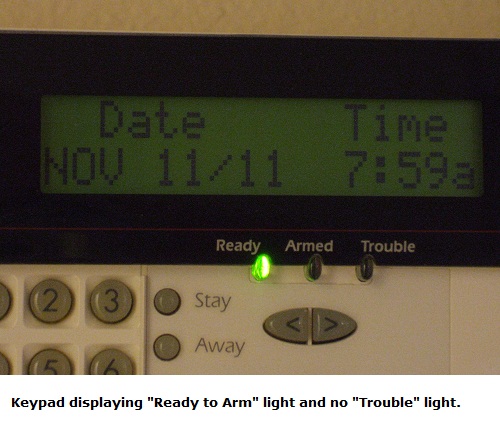
After resetting, the keypad display should be clear of any trouble lights or beeps.
If you’ve removed or bypassed any smokes or other equipment during troubleshooting, be sure to replace them as soon as possible.
Source for fire alarm wire at Amazon.com
If you haven't done so already, get a few Free Home Security Systems Quotes from companies in your area.
This will give you a good idea of what it would cost to have a system installed, as well as how much you could save by doing it yourself.
Return to Home-Security-Systems-Answers from Troubleshooting Smoke Alarm Wiring
Return to Hardwired Home Security Systems from Troubleshooting Smoke Alarm Wiring
Note: Feel free to print any of the articles on this site for personal, non-commercial use. Just look for this button:
If you found this website especially helpful, you might want to consider making a small donation. Since 2011, AzAlarmGuy has been providing free help and advice on home security systems to all of those in need.
Your gift, in any amount, will help me keep this website a free resource for anyone needing help with alarm system issues or questions.
Disclosure
I receive affiliate commissions from some of the companies and products I discuss. These commissions don't change the price that you pay.
Rest assured that this compensation does not influence my recommendations. I only endorse products and services that I truly believe to be an honest value for you, as a visitor to my site.
For more details, see my full disclaimer.
